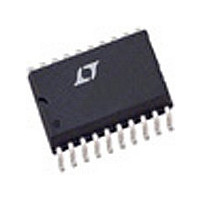LTC1753CSW#TRMPBF Linear Technology, LTC1753CSW#TRMPBF Datasheet - Page 12

LTC1753CSW#TRMPBF
Manufacturer Part Number
LTC1753CSW#TRMPBF
Description
Manufacturer
Linear Technology
Datasheet
1.LTC1753CSWTRMPBF.pdf
(24 pages)
Specifications of LTC1753CSW#TRMPBF
Lead Free Status / RoHS Status
Compliant
Available stocks
Company
Part Number
Manufacturer
Quantity
Price
APPLICATIO S I FOR ATIO
Table 3. Recommended R
LTC1753
overloads may not affect the output voltage at all. More
significant overload conditions will allow the SS pin to
reach a steady state, and the output will remain at a
reduced voltage until the overload is removed. Serious
overloads will generate a large overdrive at CC, allowing it
to pull SS down quickly and preventing damage to the
output components.
By using the R
the current limiting circuit eliminates an expensive dis-
crete sense resistor that would otherwise be required. This
helps minimize the number of components in the high
current path. Due to switching noise and variation of
R
accurate. The current limiting circuitry is primarily meant
to prevent damage to the power supply circuitry during
fault conditions. The exact current level where the limiting
circuit begins to take effect will vary from unit to unit as the
R
For a given current limit level, the external resistor from
I
where,
I
I
12
MAX
LOAD
RIPPLE
DS(ON)
DS(ON)
MAXIMUM OPERATING
R
I
LOAD CURRENT (A)
LMAX
IMAX
to V
= Maximum load current
= Inductor ripple current
, the actual current limit trip point is not highly
of Q1 varies.
IN
10
12
14
16
18
8
V
can be determined by:
I
IN
f
LOAD
I
OSC
DS(ON)
LMAX
V
OUT
L
U
I
IMAX
of Q1 to measure the output current,
O
I
R
RIPPLE
IMAX
DS ON Q
V
V
2
IN
OUT
(
U
Resistor (k ) vs Maximum Operating Load Current and External MOSFET Q1
) 1
Si4410
1.2k
820
—
—
—
—
W
U
(TWO IN PARALLEL)
Si4410
1.2k
430
560
680
820
910
f
L
R
I
OUTEN and Thermistor Input
The LTC1753 includes a low power shutdown mode,
controlled by the logic at the OUTEN pin. A high at OUTEN
allows the part to operate normally. A low level at OUTEN
stops all internal switching, pulls COMP and SS to ground
internally and turns Q1 and Q2 off. PWRGD is pulled low,
and FAULT is left floating. In shutdown, the LTC1753
quiescent current drops to about 130 A. The residual
current is used to keep the thermistor sensing circuit at
OUTEN alive. Note that the leakage current of the external
MOSFETs may add to the total shutdown current con-
sumed by the circuit, especially at elevated temperatures.
OUTEN is designed with two thresholds to allow it to also
be utilized for overtemperature protection. The power
MOSFET operating temperature can be monitored with an
external negative temperature coefficient (NTC) thermistor
OSC
IMAX
O
DS(ON)Q1
LTC1753
= Inductor value
= LTC1753 oscillator frequency = 300kHz
= Internal 190 A sink current at I
CC
–
+
= Hot on-resistance of Q1 at I
Figure 5. Current Limit Setting
190 A
SUD50N03
1.2k
1.5k
680
820
1k
—
I
MAX
I
7
FB
8
20
R
G1
G2
IMAX
V
(TWO IN PARALLEL)
IN
Q2
Q1
MAX
LMAX
MTD20N03
L
1.2k
1.5k
1.8k
2.0k
2.2k
O
1k
+
+
C
C
1753 F05
IN
1753fa
OUT
V
OUT

















